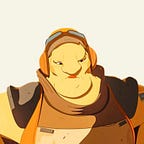The cyborg: “more machine than man”, a terrifying figuration of nightmarish androids and cybernetics. The hiss of Vader’s breathing apparatus, and the wheezing cough of his grotesque forerunner in General Grievous, suggest that cyborg bodies in Star Wars are little more than an indicator for their character’s brokenness and villainy. Technological augmentation here is a symbol of insufficiency; that these beings are ‘less-than’ in body and in soul — the worst possible tropes of disabled media representation. Cindee Calton (2018) further points to other examples of reductive disability representation in Star Wars: Saw Gerrera in Rogue One, and Chirrut Îmwe’s role as a reductive ‘supercrip’ whose disability-slash-superpower is both powerful and technology-free.
Recent Star Wars media, however, has posed more complicated depictions of disability and assistive technology. From the disability politics of Star Wars Visions: T0-B1 — a droid-or-maybe-not-droid child who can use the Force, trained by a droid-building Jedi master with no arms — to the cyborgian subculture practised by the Mods in The Book of Boba Fett, we might think of these stories in relation to both disability studies and Harawayan cyborg theory. Hendren (2018) argues that all technology is assistive; that “distinction between able-minded/able-bodied and disabled is a false divide…But a challenge remains: to interrupt cultural assumptions in powerful, creative ways — and to alter wider collective thinking about one’s own dependence and independence, and that of others. So how might designers and artists engage these myths about what is normal and make more visible, critical, and expansive technologies?” Equally, Nelson (2019) writes: “The assumptions about our bodies is that they are bad bodies to have, and that [our] psyches are impacted by having such bodies. But we don’t think about our bodies as bad: we have come to know and love them.” We can think of cybernetics then as a vehicle for creative expression, something both personal and embedded in community, while also resisting the hegemonic urge to frame ‘assistive technology’ as a ‘fix’ for a ‘personal problem’.
We might then ask: what does the Star Wars universe have to say about embodiment, augmentation, technology, and assemblage theory? How might we read cybernetics in Star Wars as something that is simultaneously a problematic signifier of monsterified others, but also as technology that gestures to other ways of living in and moving through the galaxy? And how might we speculate more complex visions of disability and cyborg technology — rooted in community, solidarity, diversity, and liberation — in the Star Wars universe going forward?
